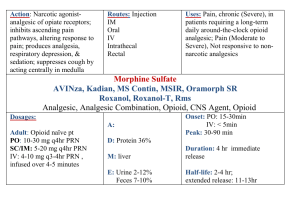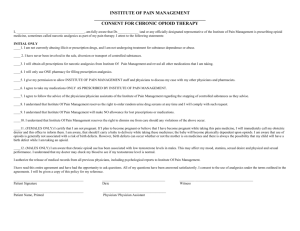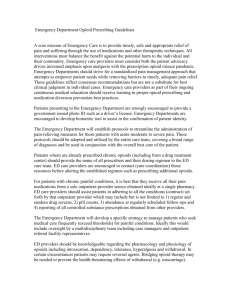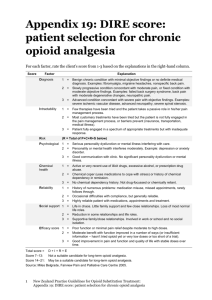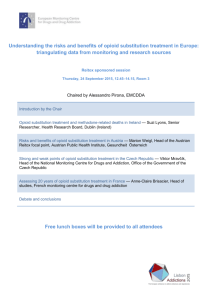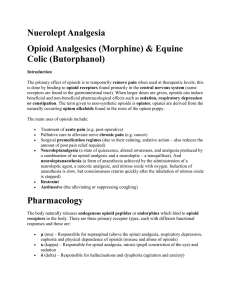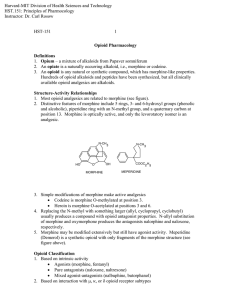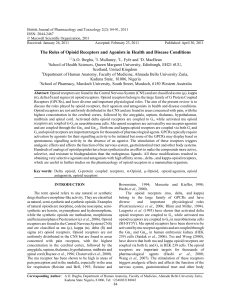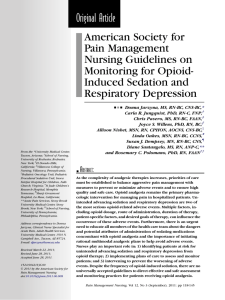Narcotic analgesics
advertisement
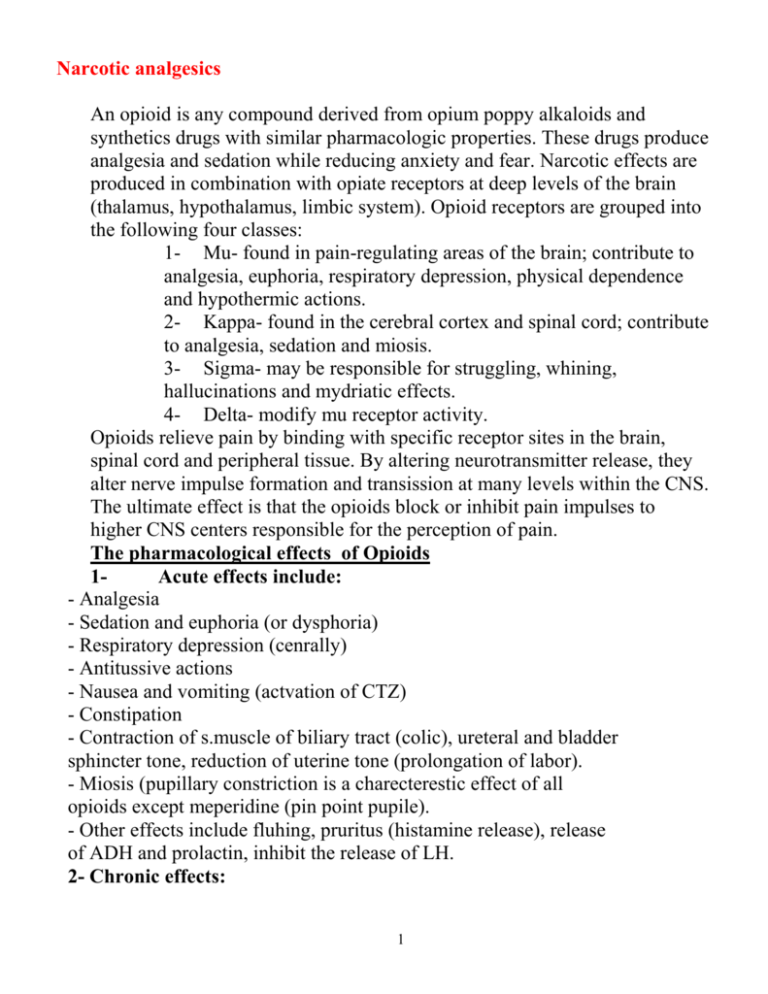
Narcotic analgesics An opioid is any compound derived from opium poppy alkaloids and synthetics drugs with similar pharmacologic properties. These drugs produce analgesia and sedation while reducing anxiety and fear. Narcotic effects are produced in combination with opiate receptors at deep levels of the brain (thalamus, hypothalamus, limbic system). Opioid receptors are grouped into the following four classes: 1- Mu- found in pain-regulating areas of the brain; contribute to analgesia, euphoria, respiratory depression, physical dependence and hypothermic actions. 2- Kappa- found in the cerebral cortex and spinal cord; contribute to analgesia, sedation and miosis. 3- Sigma- may be responsible for struggling, whining, hallucinations and mydriatic effects. 4- Delta- modify mu receptor activity. Opioids relieve pain by binding with specific receptor sites in the brain, spinal cord and peripheral tissue. By altering neurotransmitter release, they alter nerve impulse formation and transission at many levels within the CNS. The ultimate effect is that the opioids block or inhibit pain impulses to higher CNS centers responsible for the perception of pain. The pharmacological effects of Opioids 1Acute effects include: - Analgesia - Sedation and euphoria (or dysphoria) - Respiratory depression (cenrally) - Antitussive actions - Nausea and vomiting (actvation of CTZ) - Constipation - Contraction of s.muscle of biliary tract (colic), ureteral and bladder sphincter tone, reduction of uterine tone (prolongation of labor). - Miosis (pupillary constriction is a charecterestic effect of all opioids except meperidine (pin point pupile). - Other effects include fluhing, pruritus (histamine release), release of ADH and prolactin, inhibit the release of LH. 2- Chronic effects: 1 - Tolerance: marked tolerance can develop to the mentioned acute pharmacological effects except miosis and constipation. There is crosstolerance between different opioid agonists but not complete. - Dependence: Physical dependence occurs to chronic therapy with opioids particularly the strong agonists. Methadone is synthetic opioid that is used for treatment of morphine and heroin addiction in humans. Opioid agonists These are the drugs that bind with all opioid receptor sites and produce opioid effects and respiratory depression, sedation and addiction. They include morphine (natural), mepridine, codeine, fentanyl, alfentanil, sufentanil, carfentanile, etrophine, hydromorphine, methadone, oxymorphone and hydrocodone. Even though some of these drugs are considered more potent than morphine, morphine is still considered to be one of the most effective of the opiods. Clinical uses: opioid agonists are used to control moderate to severe pain in animals. Fentanyl is available as transdermal patch for control of postoperative and chronic pain in dogs and cats. Opioids are used as: 1- preanesthetics or postanesthetics because of their sedative and analgesic properties. 2They are sometimes used alone or in combination with tranqulizers as anesthetics for sergical procedures, for relief colonic pain in horses and for restraint/capture of wild/ zoo animals. 3At low doses opioids have antitussive properties owing to depression of the cough center in the brain. 4Antidiarrheal action due to reduction of peristalsis or segmental contraction. Adverse effects: inclde respiratory depression, sedation, excitement and addiction. Cats are more sensitive to the excitatory effects of opioid agonists than are other species and they tolerate low doses well. Opioid agonists-antagonists These drugs bnind with opioid kappa receptors but antagonize opioid mu recepters. They include butorphanol, pentazocine and nalbuphine. These drugs are used for mild to moderate pain and have few side effects. Adverse effects include sedation, ataxia and salivation. 2 Opioid partial agonist These drugs bind with mu receptors but only partially activate them. Buprenorphine is the primary drug effectively used in cats by the sublingual/ buccal route. Uses include relief of mild to moderate pain in dogs and horses. Adverse effects include sedation and respiratory depression. butorphanol Opioid antagonists These drugs block the effects of opioids by binding with opiate receptors, displacing narcotic molecules already present and preventing further narcotic binding at the sites. These antagonist are classified as pure antagonists or as partial antagonists, which may have some agonist activity (analgesic and respiratory depressant effects). Nalaxone is a pure opioid antagonist that is chemically similar to oxymorphone with high affinity to mu receptors. It has no agonist activity. Nalorphine ia a partial antagonist that produce unwanted analgesic and respiratory depressant effects. Both drugs are administered i.v. and exert their effects very rapidly within 15- 60 seconds. Adverse effects: nalaxone usually has few adverse effects if given in correct dose. Nalorphie may induce respiratory depression. 3
